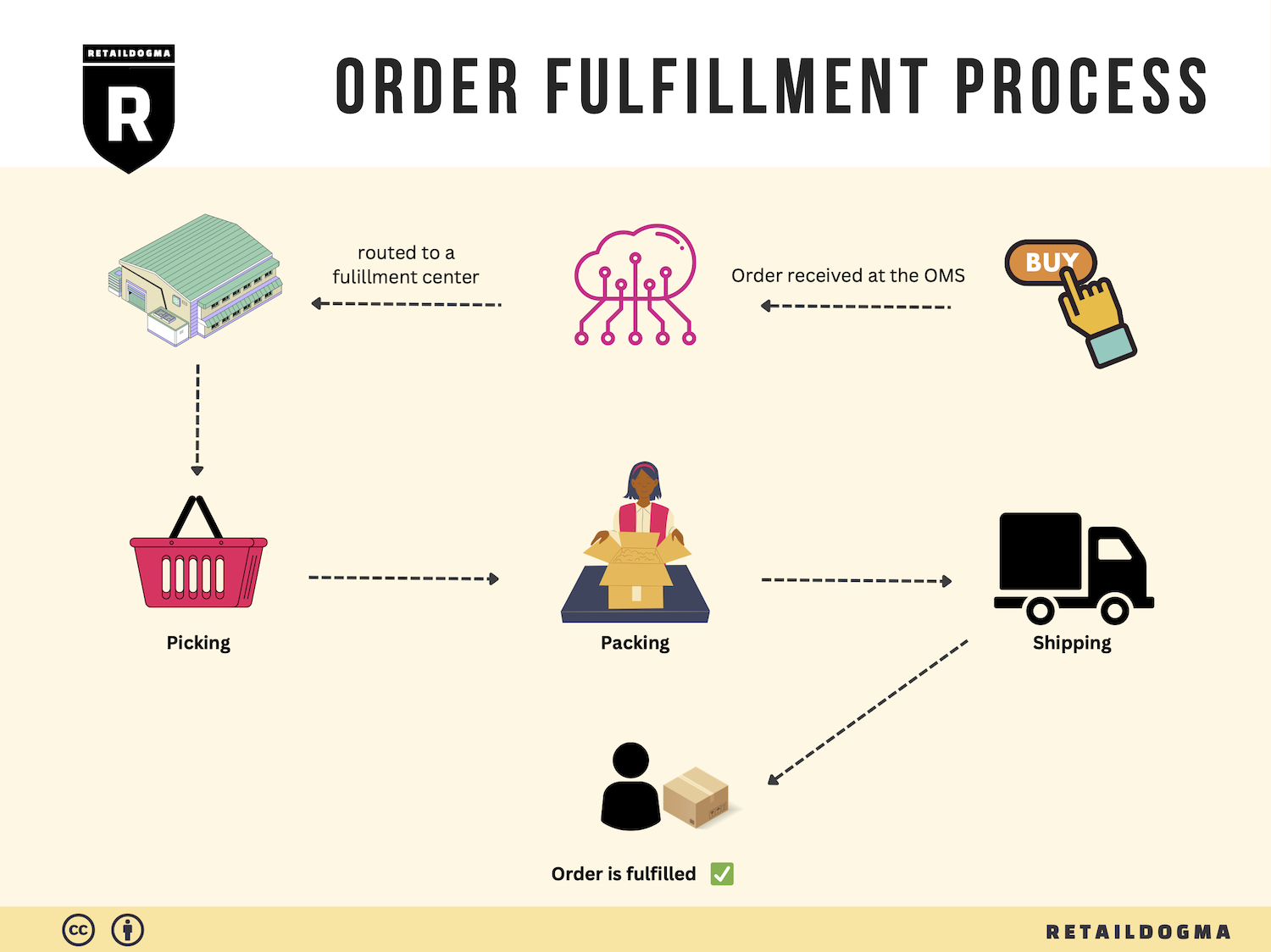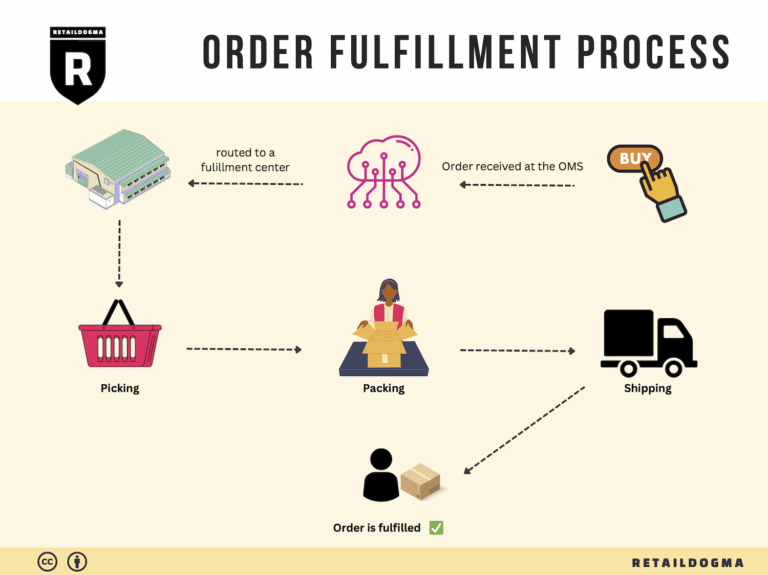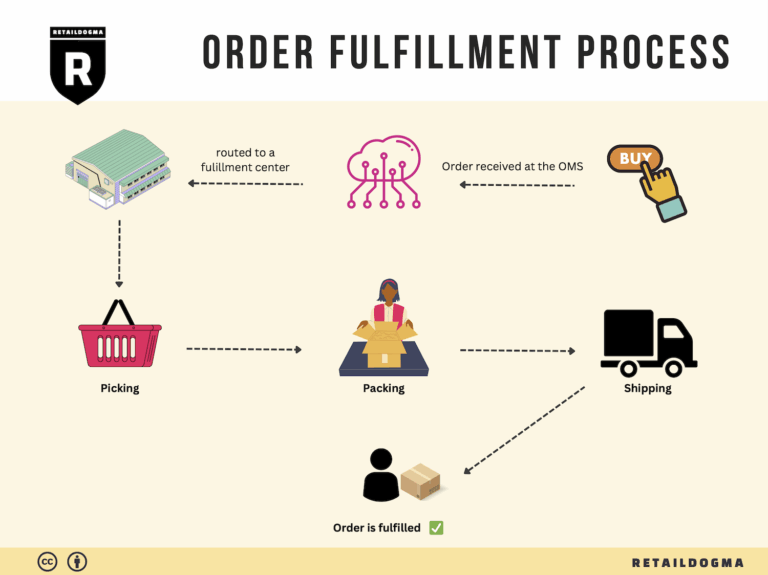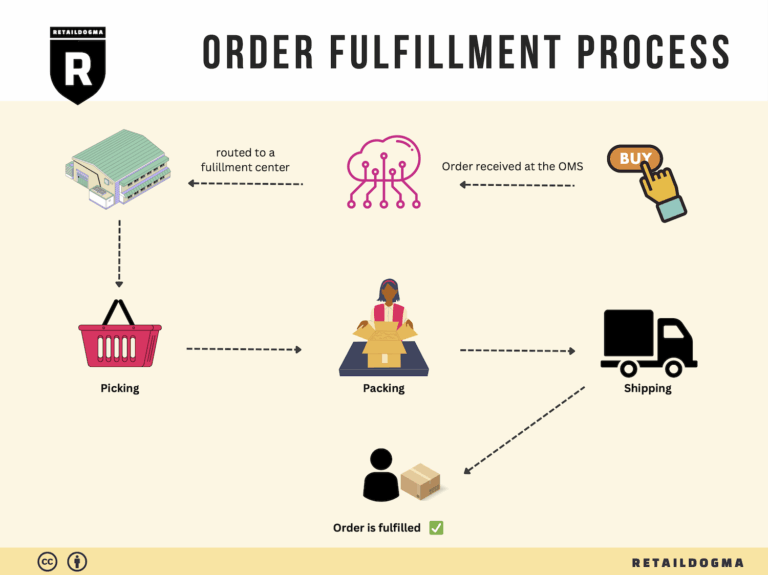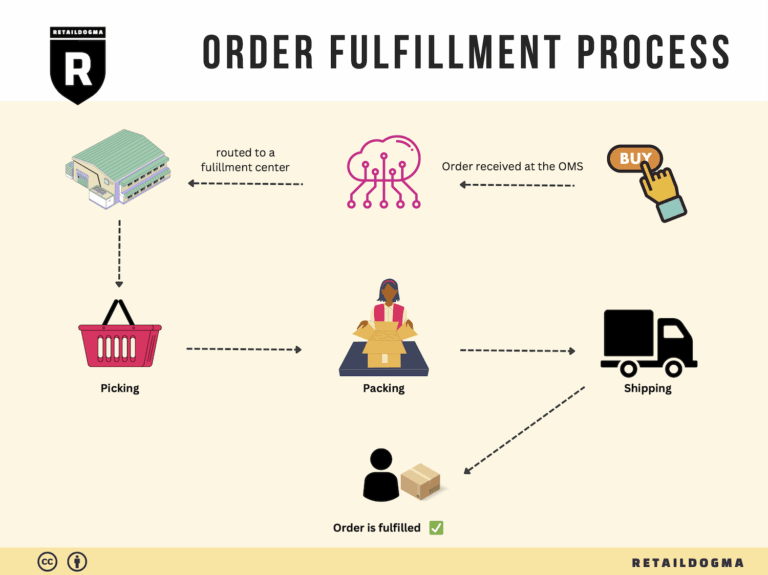How Order Fulfillment Works: A Step-by-Step Guide for Businesses
What is E-commerce Fulfillment? An Introduction for Growing Businesses
Understanding E-commerce Fulfillment: A Key to Scaling Your Business
As an e-commerce business owner, the journey of packing and shipping orders can quickly become overwhelming, especially as sales begin to grow. You may find yourself buried under a mountain of boxes, packing tape, and shipping labels, struggling to keep up with demand while ensuring that each customer receives their order on time. This is where e-commerce fulfillment comes into play—a critical process that involves getting your products from your warehouse or supplier to your customers efficiently and effectively.
At its core, fulfillment is the logistical operation of preparing and delivering a product to a customer. This includes receiving inventory, storing it, picking and packing orders, and finally shipping them out. As your business expands, managing these tasks in-house can consume valuable time and resources, diverting your focus from growth and innovation. Thus, many growing businesses turn to fulfillment services to streamline their operations and enhance customer satisfaction.
This guide aims to demystify e-commerce fulfillment by exploring various fulfillment models, including Third-Party Logistics (3PL) and Fulfillment by Amazon (FBA). Each model has its advantages and disadvantages, and understanding these can help you make informed decisions about which is best suited for your business needs.
We’ll delve into the core services that fulfillment partners typically offer, such as inventory management, order processing, and shipping. These services can significantly reduce the burden on your team and ensure that orders are handled with care and precision.
Choosing the right fulfillment partner is another critical aspect we will address. Factors such as location, technology integration, and customer service play a vital role in ensuring your logistics operations run smoothly. We’ll provide practical tips for evaluating potential partners to find one that aligns with your business goals.
Finally, we will cover the pricing structures associated with different fulfillment services, helping you understand the costs involved and how to budget effectively as you scale.
Our goal with this guide is to empower you—whether you’re a small business owner or an operations manager—to make smart, strategic decisions about your logistics. By understanding the intricacies of e-commerce fulfillment, you can enhance your operational efficiency, improve customer satisfaction, and ultimately drive growth in your business.
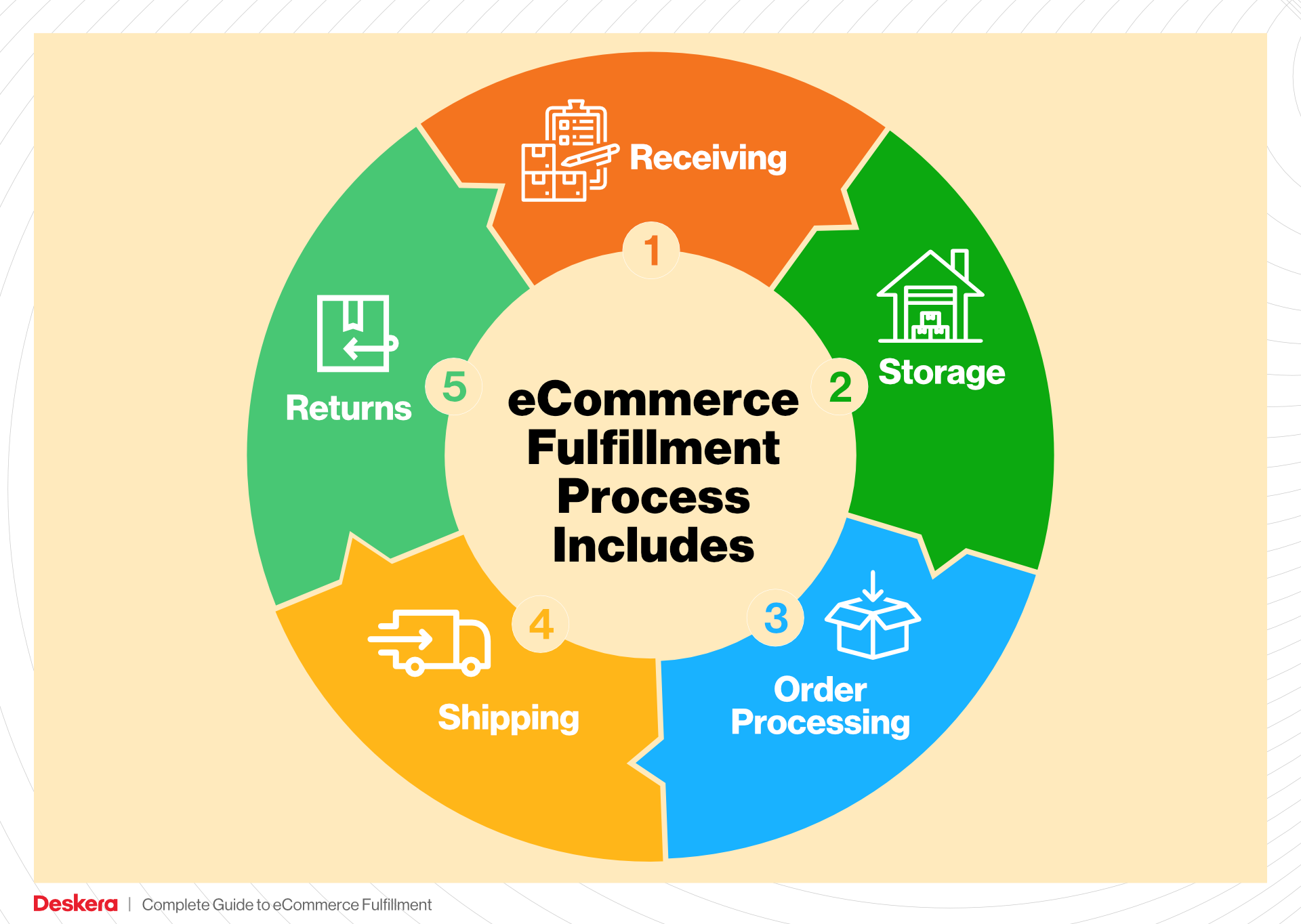
What You’ll Learn In This Guide
- What is E-commerce Fulfillment? An Introduction for Growing Businesses
- The Order Fulfillment Process: From ‘Buy’ Button to Customer’s Door
- Comparing Fulfillment Models: In-House vs. 3PL vs. Dropshipping
- A Deep Dive into Amazon FBA: Pros, Cons, and Who It’s For
- Core Services Offered by Fulfillment Centers
- How to Choose a Fulfillment Partner: A 6-Point Checklist
- Understanding Fulfillment Pricing: A Breakdown of Common Fees
- Frequently Asked Questions (FAQs) about Fulfillment
- Conclusion: Is Outsourcing Fulfillment the Right Move for Your Business?
- Important Disclaimer
The Order Fulfillment Process: From ‘Buy’ Button to Customer’s Door
1. Receiving Inventory
The first step in the order fulfillment process is receiving inventory. When products arrive at the Amazon Fulfillment Center, they are unloaded and inspected for quality and quantity. This step is critical to ensure that the correct items are received and that there are no damages.
During this phase, each product is assigned a Stock Keeping Unit (SKU), which serves as a unique identifier for inventory management. This identifier helps streamline the inventory tracking process, making it easier to locate products within the warehouse later on. Accurate receiving not only prevents stock discrepancies but also enhances overall customer satisfaction by ensuring that the right products are available for order fulfillment.
2. Warehouse Storage
Once inventory is received and sorted, it is placed into designated storage areas within the fulfillment center. This step involves organizing products in a way that optimizes space and improves accessibility. Different storage strategies, such as bulk storage or shelving, may be employed based on the type of products and their demand patterns.
Efficient warehouse storage is crucial because it directly impacts the speed and efficiency of order fulfillment. By maximizing space utilization and implementing proper layout strategies, businesses can reduce the time it takes to pick items for orders. Properly organized storage also minimizes the risk of errors and loss, which can affect inventory accuracy and lead to customer dissatisfaction.
3. Order Picking
The order picking process is where the actual items are retrieved from storage to fulfill customer orders. When a customer places an order, a pick list is generated, detailing which items need to be collected and their respective locations within the warehouse.
This step is vital because it is the link between inventory management and customer satisfaction. The faster and more accurately items are picked, the quicker orders can be processed and shipped. Utilizing technology, such as barcode scanners or automated picking systems, can significantly enhance the efficiency of this process. Additionally, implementing a system for batch picking—where multiple orders are picked simultaneously—can further streamline operations.
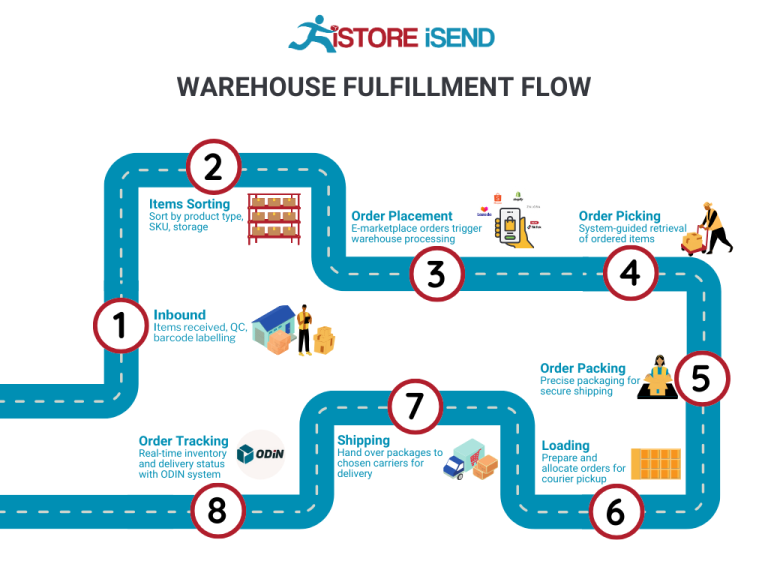
4. Order Packing
After items have been picked, they move to the packing station. During this phase, products are carefully packaged to ensure they arrive at the customer’s location in perfect condition. Packaging materials must be chosen based on the nature of the items, with fragile products requiring extra cushioning.
Packing is not just about protection; it’s also an opportunity for branding. Custom packaging can enhance the customer experience and promote brand recognition. Furthermore, accurate packing is essential for calculating shipping costs and ensuring compliance with carrier requirements. By implementing packing slip generation and quality checks, businesses can reduce the likelihood of errors, thereby improving the overall order accuracy and customer satisfaction.
5. Shipping & Delivery
The final step in the order fulfillment process is shipping and delivery. Once packages are packed, they are labeled and prepared for dispatch. Depending on the destination and shipping method chosen by the customer, packages may be sent directly to carriers such as UPS, FedEx, or USPS, or routed through a sortation center for more efficient delivery.
This step is critical for meeting customer expectations, especially in the era of fast shipping promises like Amazon Prime’s two-day delivery. Efficient shipping logistics, including route optimization and carrier selection, can significantly impact delivery times and costs. By leveraging data analytics and working closely with shipping partners, businesses can enhance their fulfillment capabilities and improve customer satisfaction.
In conclusion, mastering each step of the order fulfillment process is essential for e-commerce success. From receiving inventory to ensuring timely delivery, each phase plays a crucial role in creating a seamless experience for customers and driving operational efficiency for businesses.
Comparing Fulfillment Models: In-House vs. 3PL vs. Dropshipping
Fulfillment Model Comparison
| Model | Who Handles Inventory | Best For (Business Stage) | Key Advantage | Key Disadvantage |
|---|---|---|---|---|
| In-House Fulfillment | The e-commerce business itself | Established businesses with stable demand | Full control over inventory and processes | High overhead costs and resource demands |
| Third-Party Logistics (3PL) | A third-party logistics provider | Growing businesses and startups | Cost-effective scalability and flexibility | Less control over the fulfillment process |
| Dropshipping | Supplier or manufacturer | Startups and businesses testing markets | Low upfront investment and low risk | Lower profit margins and longer shipping times |
In-House Fulfillment
In-house fulfillment involves managing the entire inventory and order processing within your own facilities. This model is typically best suited for established businesses with a stable demand, as it allows for full control over the entire supply chain. Companies that opt for in-house fulfillment can tailor their processes to fit specific operational needs, ensuring that quality standards are met at every step. Additionally, having direct oversight allows businesses to respond quickly to inventory fluctuations, implement custom packaging, and maintain brand consistency.
However, this model comes with significant drawbacks. The costs associated with warehousing, staffing, and equipment can be substantial, especially for smaller businesses. Moreover, in-house fulfillment requires a significant commitment of time and resources to manage logistics, which may detract from other critical business functions like marketing and customer service. As companies scale, they may find that maintaining an in-house operation becomes increasingly complex and challenging, prompting a reevaluation of their fulfillment strategy.
Third-Party Logistics (3PL)
Third-party logistics (3PL) involves outsourcing the warehousing and fulfillment processes to a specialized provider. This model is particularly advantageous for growing businesses and startups that need to scale quickly without the burden of managing inventory themselves. By partnering with a 3PL provider, businesses can leverage the logistics company’s infrastructure, expertise, and technology to streamline their operations. This can lead to cost savings, as 3PLs can often negotiate better shipping rates and optimize logistics more effectively than an individual business could.
Despite its advantages, relying on a 3PL does have its downsides. One of the primary concerns is the reduction in control over the fulfillment process. Businesses must trust that the 3PL will uphold their standards for inventory management and customer service. Additionally, potential communication issues can arise, especially if the 3PL is not aligned with the business’s goals and expectations. For companies that prioritize brand experience and customer satisfaction, finding a reliable 3PL that meets these standards is essential.
Dropshipping
Dropshipping is a fulfillment method where the retailer does not keep products in stock but instead transfers customer orders and shipment details directly to the supplier or manufacturer, who then ships the products directly to the customer. This model is particularly suitable for startups and businesses looking to test new markets or product lines without committing significant capital upfront. The primary advantage of dropshipping is the low initial investment required; businesses can operate without the need for inventory, warehousing, or extensive logistics management.
However, dropshipping comes with notable challenges. One significant drawback is the lower profit margins, as suppliers often charge higher wholesale prices to cover their own costs. Additionally, shipping times can be longer, especially if products are sourced from overseas manufacturers. This can impact customer satisfaction and brand loyalty, as consumers increasingly expect fast shipping. Furthermore, businesses have limited control over the fulfillment process, including product quality and inventory levels, which can lead to issues if the supplier fails to meet expectations.
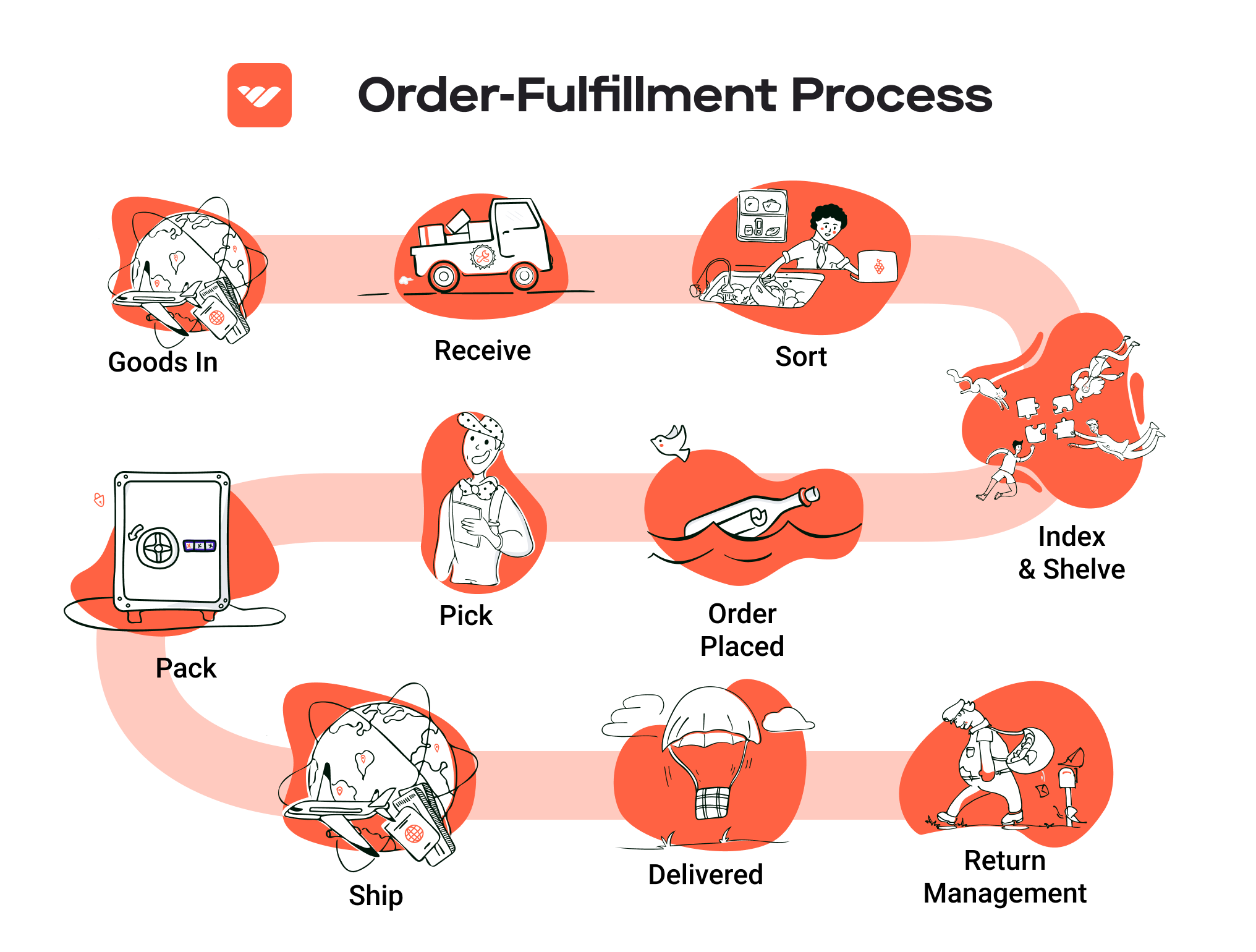
Conclusion
Selecting the right fulfillment model is a critical decision for e-commerce businesses aiming to scale. Each model—whether in-house fulfillment, third-party logistics, or dropshipping—offers unique benefits and challenges. Understanding these differences will empower business owners to make informed decisions that align with their operational goals, customer expectations, and financial capabilities. As businesses evolve, they may find that their fulfillment needs change, necessitating a flexible approach to logistics that can adapt to market demands.
A Deep Dive into Amazon FBA: Pros, Cons, and Who It’s For
Understanding Fulfillment by Amazon (FBA)
Fulfillment by Amazon (FBA) is a service offered by Amazon that allows e-commerce sellers to store their products in Amazon’s vast network of fulfillment centers. When a customer places an order for a product fulfilled by FBA, Amazon takes care of storage, packaging, shipping, and customer service. This service has revolutionized the logistics landscape for many online businesses, particularly small to medium-sized enterprises looking to scale their operations without the overhead of managing their own warehousing and shipping.
When you enroll in FBA, your products are listed on Amazon, and you have access to Amazon’s Prime customer base. This means that products eligible for Prime shipping can be delivered to customers within two days, significantly enhancing the shopping experience. Sellers send their inventory to Amazon’s fulfillment centers, where it is stored until sold. Amazon handles the rest, including order processing and returns.
How FBA Works
-
Inventory Setup: Sellers create an FBA account and list their products. They then send their inventory to Amazon’s designated fulfillment centers. Amazon has over 180 fulfillment centers strategically located, such as the OAK3 facility in Patterson, California, which spans over 1.5 million square feet, ensuring efficient nationwide distribution.
-
Storage and Management: Once your inventory is received, Amazon stores it in their warehouses. The company utilizes sophisticated technology to manage inventory levels and locations, which helps in efficient picking and packing.
-
Order Processing: When a customer orders a product, Amazon picks the item from the shelf, packs it, and ships it directly to the customer. This process is highly automated, allowing for fast and efficient order fulfillment.
-
Customer Service: Amazon also handles all customer service inquiries related to FBA orders, including returns and refunds. This relieves sellers of the burden of managing customer interactions.
-
Payment: After the order is shipped, Amazon transfers the proceeds from the sale to the seller’s account, minus the applicable fees.
Pros of FBA
-
Prime Eligibility: One of the most significant advantages of using FBA is access to Amazon Prime customers. Products fulfilled by Amazon are eligible for Prime shipping, attracting a vast customer base willing to pay for fast delivery.
-
Customer Trust: Selling through Amazon lends credibility to your business. Customers often prefer purchasing from sellers using FBA because they trust Amazon’s brand and customer service.
-
Multi-Channel Fulfillment: FBA allows sellers to fulfill orders from multiple sales channels, not just Amazon. You can sell on your own website or other platforms while utilizing Amazon’s fulfillment capabilities, streamlining logistics across your entire business.
-
Scalability: FBA provides a scalable solution for growing businesses. You can quickly increase your inventory and expand your product offerings without needing to invest in additional warehouse space or staff.
-
Simplified Logistics: With FBA, sellers can focus on marketing and product development instead of worrying about shipping logistics, which can be a significant time and resource drain.
Cons of FBA
-
High Fees: While FBA offers many benefits, it comes with costs. Sellers must pay for storage fees based on the volume of inventory stored and fulfillment fees for each order processed. These fees can add up quickly, especially for slow-moving products.
-
Strict Inventory Rules: Amazon has stringent requirements for inventory management. Sellers must adhere to policies regarding packaging, labeling, and performance metrics. Non-compliance can lead to additional fees or even account suspension.
-
Commingling Risks: FBA can lead to commingling of inventory, where products from different sellers are stored together. This can pose risks for brand integrity and product authenticity, as sellers may receive returns of items that are not their own.
-
Limited Control: When using FBA, sellers relinquish some control over the fulfillment process. This means that issues like shipping delays or product handling are in Amazon’s hands, which can impact customer satisfaction.
-
Long-Term Storage Fees: If inventory sits unsold for an extended period, sellers may incur long-term storage fees, which can significantly erode profit margins.
Who is FBA Best For?
FBA is particularly beneficial for:
-
Small to Medium-Sized Businesses: Companies looking to scale quickly without the overhead of managing warehousing and logistics can leverage FBA to expand their reach and sales.
-
E-commerce Entrepreneurs: Those who are just starting out and want to tap into Amazon’s vast customer base will find FBA a valuable tool for growth.
-
Brands with High Turnover Products: Sellers with products that sell quickly will benefit from FBA, as the costs associated with storage and fulfillment will be offset by high sales volumes.
-
Businesses Seeking to Enhance Customer Service: Brands that want to provide superior customer service without the burden of managing returns and inquiries can rely on Amazon’s customer service capabilities.
In conclusion, Fulfillment by Amazon offers a powerful solution for e-commerce businesses aiming to streamline their logistics and tap into Amazon’s extensive customer base. However, it is essential for potential users to weigh the pros and cons carefully, considering their specific business model and growth strategy before making the leap into FBA.
Core Services Offered by Fulfillment Centers
Inventory Management & Warehousing
Inventory management and warehousing are fundamental services provided by fulfillment centers, enabling e-commerce businesses to efficiently store and manage their products. Fulfillment centers like Amazon’s OAK3 are equipped with advanced inventory management systems that track stock levels in real-time. This technology allows businesses to maintain optimal inventory levels, ensuring they have enough products to meet customer demand without overstocking.
The benefits of effective inventory management are multifold. It reduces the risk of stockouts, which can lead to missed sales and dissatisfied customers. Additionally, it minimizes excess inventory that ties up capital and incurs storage costs. By utilizing a fulfillment center’s warehousing capabilities, e-commerce businesses can scale their operations without the need for significant investment in physical storage space. This flexibility is crucial for adapting to market fluctuations and seasonal demand, ultimately leading to improved cash flow and profitability.
Pick and Pack Services
Pick and pack services are integral to the order fulfillment process. This service involves selecting (picking) the correct items from the warehouse and preparing (packing) them for shipment to customers. Fulfillment centers streamline this process through efficient layout designs, technology, and trained personnel who ensure accuracy and speed.
The primary benefit of pick and pack services is the enhancement of order accuracy and delivery speed. By outsourcing these tasks to a specialized fulfillment center, e-commerce businesses can focus on their core activities, such as marketing and customer engagement. Fast and accurate order fulfillment is particularly vital in today’s e-commerce landscape, where customers expect rapid delivery and seamless shopping experiences. Moreover, fulfillment centers often have established relationships with shipping carriers, allowing for competitive shipping rates and reliable delivery options.
Kitting and Assembly
Kitting and assembly services involve bundling multiple products into a single package or assembling components into a finished product before shipping. This service is particularly beneficial for businesses that sell products that are often purchased together, such as gift sets, or for those that require assembly, like furniture or electronics.
The advantages of kitting and assembly are significant. It simplifies the ordering process for customers, as they receive a ready-to-use product rather than multiple components. This can lead to increased average order value and customer satisfaction. Additionally, kitting reduces the time and labor costs associated with preparing orders. By utilizing a fulfillment center’s kitting services, e-commerce businesses can enhance their product offerings while reducing operational complexity. This service also allows businesses to respond quickly to market trends and customer preferences, thereby increasing competitiveness.
Returns Management (Reverse Logistics)
Returns management, often referred to as reverse logistics, is a critical service offered by fulfillment centers that involves handling product returns efficiently. This process includes receiving returned items, inspecting them, restocking them if they are in sellable condition, or managing their disposal if they are not. Proper returns management is essential for maintaining customer satisfaction and loyalty, as an easy return process can significantly influence a customer’s shopping experience.
The benefits of effective returns management are profound. It enhances customer trust, as consumers are more likely to purchase from businesses that offer hassle-free returns. Efficient handling of returns can also minimize losses by quickly restocking sellable items and reducing the time products spend in the return pipeline. Furthermore, fulfillment centers often analyze return data to identify trends and issues, allowing businesses to make informed decisions about product quality and customer preferences. By leveraging returns management services, e-commerce businesses can turn potential losses into opportunities for improvement and customer retention.
In summary, fulfillment centers like Amazon’s OAK3 provide essential services that can significantly enhance the operational efficiency of e-commerce businesses. From inventory management and pick and pack services to kitting and returns management, these core offerings enable businesses to scale effectively, improve customer satisfaction, and ultimately drive growth. By partnering with a fulfillment center, e-commerce entrepreneurs can focus on strategic initiatives while ensuring their logistics operations are handled by experts.
How to Choose a Fulfillment Partner: A 6-Point Checklist
Location & Warehouse Network
Importance:
The geographical location of a fulfillment partner’s warehouses directly impacts shipping times, costs, and overall service efficiency. A partner with strategically placed warehouses can help you reach customers faster and reduce shipping expenses.
Questions to Ask:
– Where are your warehouses located, and how do they align with our target market?
– What is your average shipping time to key regions?
– Do you have a network of fulfillment centers that can accommodate seasonal demand fluctuations?
Technology & Integrations
Importance:
The technology used by your fulfillment partner is critical for seamless operations. A robust technology platform can provide real-time inventory tracking, order management, and reporting, making it easier to manage your supply chain effectively.
Questions to Ask:
– What technology platforms do you use for inventory management and order processing?
– Can your system integrate with our e-commerce platform (e.g., Shopify, WooCommerce, Amazon)?
– Do you offer real-time tracking for orders, and how can we access this information?
Specializations (e.g., Cold Storage, Oversized Items)
Importance:
Depending on your product types, you may require specialized handling. For instance, if you sell perishables, you’ll need a partner with cold storage capabilities. Similarly, if you deal with oversized or fragile items, ensure the partner has experience and the right facilities to handle such products.
Questions to Ask:
– Do you have specialized facilities for our type of products (e.g., cold storage, hazardous materials)?
– What experience do you have in handling products similar to ours?
– How do you ensure compliance with safety and storage regulations for specialized items?
Scalability & Capacity
Importance:
As your business grows, your fulfillment needs will evolve. It’s crucial to partner with a 3PL that can scale its services to match your growth trajectory without compromising service quality.
Questions to Ask:
– What is your current capacity, and how do you manage peak seasons or sudden increases in demand?
– Can you provide examples of how you’ve supported other clients during their growth phases?
– What plans do you have for expanding your capabilities in the near future?
Pricing and Contracts
Importance:
Understanding the pricing structure and contract terms is essential to ensure that your partnership remains financially viable. Hidden fees or unfavorable terms can quickly erode your margins.
Questions to Ask:
– Can you provide a clear breakdown of all costs associated with your services (e.g., storage fees, pick and pack fees, shipping costs)?
– Are there any hidden fees we should be aware of?
– What are the terms for contract renewal or termination, and what notice period is required?
Customer Support & Reviews
Importance:
Reliable customer support can make a significant difference in resolving issues quickly and maintaining a smooth operation. Additionally, reviewing testimonials and feedback from existing clients can offer insights into the partner’s reliability and service quality.
Questions to Ask:
– What support channels do you offer (e.g., phone, email, chat), and what are your response times?
– Can you provide references or case studies from businesses similar to ours?
– How do you handle issues or complaints, and what is your typical resolution timeline?
Conclusion
Choosing the right fulfillment partner is a critical decision that can significantly influence your e-commerce business’s success. By using this checklist, you can systematically evaluate potential partners to ensure they align with your operational needs and growth objectives. Take the time to ask the right questions and conduct thorough due diligence to establish a partnership that enhances your logistics capabilities and supports your business goals.
Understanding Fulfillment Pricing: A Breakdown of Common Fees
Initial Setup Fees
When engaging with a fulfillment service, businesses often encounter initial setup fees. These fees cover the onboarding process, which may include account creation, software integration, and training on how to manage the fulfillment process effectively. The setup fee can vary significantly based on the complexity of your needs and the fulfillment center’s infrastructure.
Typically, the initial setup fee can range from a few hundred to several thousand dollars. Factors influencing this cost include the number of products being stored, the level of service required (such as custom packaging), and the specific technology integrations needed. It’s essential to inquire about what is included in these fees to avoid unexpected costs later on.
Receiving Fees
Receiving fees are charged when the fulfillment center processes incoming inventory. This fee typically covers the labor involved in unloading, inspecting, and entering the products into the inventory management system.
Calculations for receiving fees may be based on the number of pallets or boxes received, with typical costs ranging from $20 to $50 per pallet or box. Some providers may also charge based on the total weight or volume of the shipment. Understanding how your inventory arrives and the associated costs is vital for accurate budgeting, especially for businesses with frequent inventory shipments.
Storage Fees (per pallet/bin)
Once your products are in the fulfillment center, storage fees come into play. These fees are usually charged on a monthly basis and can be calculated per pallet or per bin, depending on how the fulfillment center organizes its inventory.
Storage fees can vary widely, often ranging from $10 to $40 per pallet per month. In some cases, fulfillment centers might offer tiered pricing based on the volume of storage used, incentivizing businesses that store larger quantities. It’s important to monitor your inventory turnover rates to minimize storage costs, as excess inventory can lead to higher fees.
Pick & Pack Fees (per item/order)
Pick & pack fees are charged each time an order is processed, encompassing the picking of items from storage and packing them for shipment. This fee structure can vary based on the complexity of the order and the number of items included.
Typically, pick and pack fees range from $1 to $5 per item, with additional charges for special packaging or handling requirements. Some fulfillment centers may have a minimum order fee, ensuring that even small orders are profitable for them. To optimize costs, businesses should aim for streamlined order processing and consider consolidating orders where feasible.
Shipping Fees
Shipping fees are one of the most significant costs associated with fulfillment and can vary based on several factors, including the shipping method, destination, and weight of the package. Fulfillment centers often negotiate shipping rates with carriers, which may result in better pricing for their clients.
These fees can be calculated per shipment, with common rates depending on weight brackets and destination zones. Businesses should also consider the potential for additional charges, such as fuel surcharges or residential delivery fees. Understanding the shipping options available and their associated costs can help businesses make informed decisions about their logistics strategy.
Tips for Getting an Accurate Quote
-
Detail Your Needs: Provide potential fulfillment partners with a comprehensive overview of your business model, including product types, average order size, and expected order volume. This information allows them to tailor their quote to your specific needs.
-
Ask for Itemized Pricing: Request an itemized breakdown of all fees associated with their services. This transparency will help you understand where your costs will arise and allow for better comparison between providers.
-
Inquire About Volume Discounts: Some fulfillment centers offer discounts based on the volume of inventory or orders processed. Understanding these thresholds can help you save money in the long run.
-
Evaluate Contract Terms: Pay attention to contract length and terms related to fee adjustments. Some providers may lock in rates for a certain period, while others might increase fees annually.
-
Request a Trial Period: If possible, negotiate a trial period to evaluate the fulfillment service before committing long-term. This approach allows you to assess efficiency, service quality, and overall costs before making a significant investment.
By understanding these common fulfillment pricing models and following these tips, e-commerce business owners can better navigate their logistics needs and find a fulfillment partner that aligns with their growth objectives.
Frequently Asked Questions (FAQs) about Fulfillment
1. What is the OAK3 Amazon Fulfillment Center?
The OAK3 Amazon Fulfillment Center, located in Patterson, California, is a large-scale facility measuring 1,556,000 square feet. It serves as a hub for storing, processing, and shipping products for Amazon’s Fulfillment by Amazon (FBA) service, enabling businesses to leverage Amazon’s logistics network to reach customers efficiently.
2. How does the OAK3 Fulfillment Center support e-commerce businesses?
OAK3 provides e-commerce businesses with access to Amazon’s extensive logistics infrastructure. By utilizing FBA, sellers can store their inventory at OAK3, allowing for faster order processing and shipping, often within two days for Prime customers. This capability helps businesses scale their operations and enhance customer satisfaction.
3. What’s the difference between a warehouse and a fulfillment center?
A warehouse is primarily focused on storing goods, while a fulfillment center is designed to handle the complete order fulfillment process, including receiving inventory, storing it, picking and packing orders, and shipping them directly to customers. Fulfillment centers often incorporate advanced technology to streamline these processes.
4. What is a 3PL, and how does it relate to fulfillment centers?
A 3PL, or third-party logistics provider, offers logistics services including transportation, warehousing, and order fulfillment. Many e-commerce businesses partner with 3PLs to handle their logistics needs. Fulfillment centers like OAK3 can act as a 3PL, allowing businesses to outsource their storage and fulfillment processes.
5. How much do fulfillment services cost?
Fulfillment service costs can vary widely based on several factors, including the volume of orders, size and weight of products, storage space required, and additional services like packaging and labeling. Generally, businesses should expect to pay a combination of storage fees, fulfillment fees per order, and shipping costs. It’s advisable to get a detailed quote based on your specific needs.
6. What types of products can be stored at the OAK3 Fulfillment Center?
OAK3 can accommodate a wide range of products, from electronics and household items to clothing and accessories. However, there are restrictions on certain categories, such as hazardous materials or perishables. Sellers should consult Amazon’s guidelines to ensure their products are eligible for storage at the fulfillment center.
7. How does the shipping process work from OAK3?
Once an order is placed, the fulfillment process at OAK3 involves picking the items from storage, packing them securely, and shipping them out via Amazon’s logistics network. Orders may be dispatched directly to the customer or sent to a sortation center for further processing, ensuring efficient delivery times.
8. Can I track my inventory stored at OAK3?
Yes, Amazon provides sellers with access to inventory management tools within their Seller Central account. These tools allow you to track stock levels, monitor shipments, and view order statuses in real-time, helping you maintain visibility over your inventory stored at OAK3.
9. What are the advantages of using the OAK3 Fulfillment Center?
The key advantages include access to Amazon’s vast logistics network, faster delivery times, reduced shipping costs, and the ability to scale operations without the overhead of managing your own warehouse. Additionally, utilizing FBA can enhance your product visibility and attract more customers through Amazon Prime.
10. How do I get started with using the OAK3 Fulfillment Center for my business?
To begin using the OAK3 Fulfillment Center, you need to enroll in Amazon’s FBA program. This involves setting up your Seller Central account, listing your products, and shipping your inventory to the OAK3 facility. Amazon provides detailed guidelines and support throughout the onboarding process to ensure a smooth transition.
Conclusion: Is Outsourcing Fulfillment the Right Move for Your Business?
Evaluating the Benefits of Outsourcing Fulfillment
Outsourcing fulfillment can be a transformative strategy for e-commerce businesses aiming to scale efficiently. One of the primary benefits is time savings. By entrusting order processing, storage, and shipping to a dedicated fulfillment partner, business owners can redirect their focus toward core activities such as marketing, product development, and customer engagement. This shift in focus can lead to enhanced business growth and innovation.
Scalability is another compelling reason to consider outsourcing. As your sales volume fluctuates, a proficient fulfillment service can seamlessly adjust to meet demand without the need for significant investment in infrastructure or staffing. This flexibility is crucial in today’s fast-paced market, where consumer preferences can change rapidly.
Moreover, partnering with an experienced fulfillment provider brings expertise that can enhance operational efficiency. These partners often have advanced technology, logistics knowledge, and established relationships with carriers that can result in faster shipping times and reduced costs. This not only improves customer satisfaction but can also help businesses leverage shipping options that align with their strategic goals.
However, the choice of fulfillment partner is paramount. Selecting a provider that aligns with your business needs, understands your market, and offers reliable service is essential for sustained growth. Conducting a thorough audit of your current shipping processes can help identify inefficiencies and clarify whether a fulfillment partner could be the right next step for your business.
Take Action
As you consider the potential of outsourcing fulfillment, take a moment to evaluate your current logistics operations. Are you experiencing bottlenecks, high shipping costs, or customer complaints? If so, it may be time to explore fulfillment options that can help you streamline operations and propel your business forward.
Important Disclaimer
⚠️ Important Disclaimer
The information in this guide is for educational purposes. Fulfillment services, pricing, and platform features change frequently. Always conduct your own due diligence and consult with providers directly before making business decisions.
